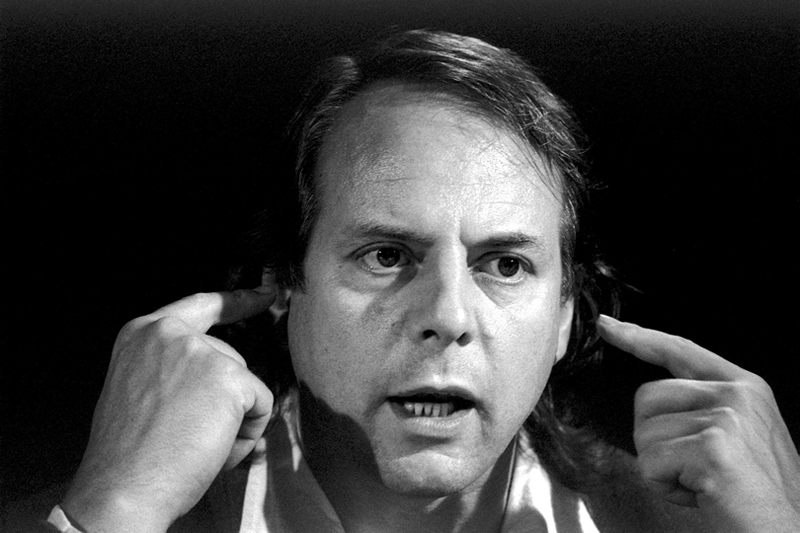
Instrumentation Works for Orchestra
Stockhausen Complete Edition on CD
Since 1991, a complete edition of all recordings in which Karlheinz Stockhausen has personally participated is being released on compact discs. Each CD in this series is identified by Stockhausen's signature followed by an encircled number. The numbers indicate the general historical order of the works.
Stockhausen realised the electronic music and participated in these recordings as conductor, performer, sound projectionist, and musical director. He personally mixed down the recordings, mastered them for CDs, wrote the texts and drew the covers.
- The compact discs may be obtained from the Stockhausen-Verlag: Kettenberg 15, 51515 Kuerten, Germany (www.stockhausenCDs.com).
Karlheinz Stockhausen
Instrumentation Works for Orchestra
ORCHESTRA FINALISTS
Introduction
for orchestra, electronic music and sound projectionist
is the second scene of WEDNESDAY from LIGHT.
It may be performed either staged or in a quasi concert version.
Staged, its duration is 46 minutes; a quasi concert version lasts 2 x 46 minutes.
The composition ORCHESTRA FINALISTS presents orchestra musicians
as finalists, in the way musicians publicly perform during music competitions. Whereas in the normal orchestral repertoire the musicians play together and only seldom have short solos, the present score for
ORCHESTRA FINALISTS consists of soli with a few tutti chords and a tutti finale. In a quasi concert performance, the soli should be played in two rounds with 13 plus 12 (or 11) musicians, each time by different instrumentalists. This enables the listeners to compare and to become more familiar with the soli. The percussionist (and possibly the hom player) is the same in both rounds. All soli are to be played from memory.
These days, many orchestral musicians aspire to play soloistically without risking a career as soloist. I am therefore hoping that orchestra musicians will also be interested in playing the roles of the ORCHESTRA FINALISTS, through which they demonstrate their musicality and skill by a new style of interpretation: playing from memory, moving in an individual
way and projecting their personal aura.
The score is dedicated to all orchestra finalists.
In the second scene of a staged performance of WEDNESDAY from LIGHT, 13 ORCHESTRA FINALISTS play only one round immediately following WORLD PARLIAMENT for cappella choir.
Two synchronous 8-track tapes — and 2-track tapes for rehearsals only — of the electronic music, as well as various stereo mixes (instruments only, electronic music only, instruments plus electronic music) for rehearsals may be ordered from the Stockhausen-Verlag (see Sound Equipment).
In concerts, the 11 soli for oboe, violoncello, clarinet, bassoon, violin, tuba, flute, trombone, viola, trumpet, and double bass may also be performed individually or in groups together with tape. 11 separate, individually entitled scores have been published for this purpose (see page X).
World première
The score of ORCHESTRA FINALISTS was commissioned in 1993 by Jan
van Vlijmen, director of the Holland Festival. The world première took place on June 14th 1996 at the CARRÉ theatre in Amsterdam during the Holland Festival.
The following musicians of the Asko Ensemble performed:
| lst round | 2nd round | |
| Oboe | Marieke Schut | Bram Kreeftmeijer |
| Cello | Taco Kooistra | Doris Hochscheid |
| Clarinet | Barbara Bouman | Hans Colbers |
| Bassoon | Jos Lammerse | Margreet Bongers |
| Violin | Jan Erik van Regteren Altena | Erik Kromhout |
| Tuba | Hans Nickel | Hans Nickel* |
| Flute | Eline van Esch | Kathinka Pasveer |
| Trombone | Toon van Ulsen | Harrie de Lange |
| Viola | Bernadette Verhagen | Liesbeth Steffens |
| Trumpet | Hendrik-Jan Lindhout | Cyrille van Poucke |
| Double Bass | Roos Heggen | Piet Smithuysen |
| Horn | Wim Timmermans | Wim Timmermans |
| Percussion | Peppie Wiersma | Peppie Wiersma |
* A second tuba player, Anne Jelle Visser, had rehearsed with Stockhausen and
recorded the solo, but fell ill just before the dress rehearsal
Musical direction and sound projection: K. Stockhausen.
Performance practice
At the rear of the stage are 11 chairs and music stands, and at the front, one chair for the cello.
For the amplification, Option A or Option B may be used.
There must be a passage of circa 2 m between the chairs and the back
wall of the stage. In Option A, 5 microphones for the soli stand at the front
of the stage, and in addition, 3 each at the rear left and right for the final
tutti. Tuba, trombone, viola and trumpet have transmitters.
A staircase with 6 steps leading to the hall is located at the center of the
stage apron.
The sound projectionist is seated at a mixing console in the middle of
the hall.
Option A:
 = cable microphone
= cable microphone
 = transmitter
= transmitter
Alternatively, with Option B, instead of 11 microphones, 10 transmitters  plus 6 cable microphones may
plus 6 cable microphones may  be used:
be used:
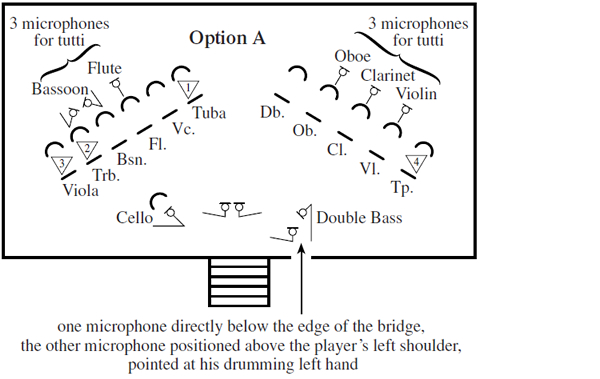
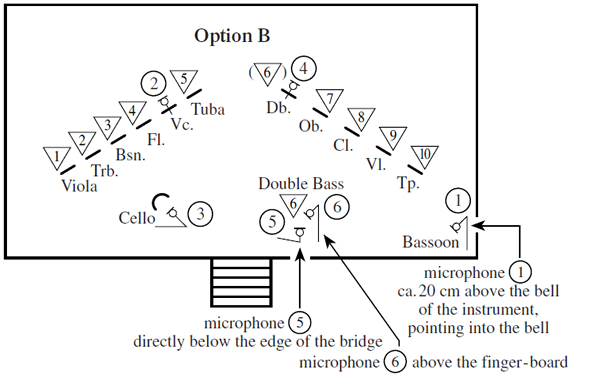
At the beginning, 11 musicians with their instruments enter from the left -
in the order of the instrument signals on the tape - and sit down on the
chairs. Their bearing is concentrated all the time as they listen attentively,
and they retain this formal attitude throughout the entire performance.
At circa l'26" the oboist walks to the two microphones at the front
(Option A) and at 1'44" begins the solo (duration ca. 3'05 "). At the places
indicated, he (she) gives the entries for 5 chords which all the musicians
play. In the 10 seconds which follow the solo, the oboist retums to his (her)
chair. The cellist then comes to the microphone which is specially prepared
for the cello. At 5 'l6" he (she) sits down and at 5 '26" begins to play.
Similarly, the other musicians play their soli in succession. The timing of each entry is indicated at the top of each solo part. The musicians each
conduct 5 chords at the places indicated, giving the upbeats with their in-
struments.
The order of the soli is: oboe - violoncello - clarinet - bassoon - violin -
tuba - flute - trombone - viola - trumpet - double bass.
During the double bass solo, a percussionist strikes a Chinese opera gong
once.
As the solos follow one another, the sound-space of the octophonic electronic music changes, dynamically adjusted by the sound projectionist to the playing of each instrumentalist.
The manner of performing with gestures and movements is prescribed for each instrument.
During the performance, a hom player plays outside in the corridors. He
(she) can be heard occasionally in the distance, and enters only before the
final tutti, walking through the auditorium to the stage (compare CD 52).
10 seconds after the end of the double bass solo (at circa 41'24") the horn player enters at the rear of the auditorium, playing his part from the beginning (regardless of the point he has reached in his part). Alternatively, he may enter from a side door in front of the stage. In 26 seconds he arrives on stage, where he stands in front of the central microphones and plays into the auditorium. He sometimes turns to the left and light towards the other musicians, and three times tums his back to the audience.
He repeats his solo a second and third time, replacing the l minute silence
by a pause of = 9 seconds, and so finishes playing at about 45' 14" together
with the double bass. He then walks out at the right.
= 9 seconds, and so finishes playing at about 45' 14" together
with the double bass. He then walks out at the right.
Circa 26 seconds after the double bass has finished playing, all stand up and walk to the microphones – if the rear microphones are used (Option A) – concentrating on the loudspeakers. Circa 36 seconds after the double bass has finished playing, the oboist begins to play his (her) solo again. One after another, all enter at intervals of 4 seconds in the order of the soli as previously played, each playing his solo once again, this time superimposed polyphonically.
Cello, bassoon and double bass play at their microphones. The musicians who do not have transmitters play in front of the microphones at the rear left and right (see illustration Option A). The four with transmitters, or – if 10 transmitters are used (Option B) – all the others who have transmitters may move freely. The trumpeter does not go down the steps again into the hall, but rather moves back and forth on the stage from the middle to the right.
The orchestra chords are not played in the tutti.
After finishing his part, each musician exits at the right (see form scheme of the tutti). The tutti ends at circa 45'53".
In a quasi concert performance, the second round begins after the intermission with 11 other musicians on the stage and a horn player outside in the corridors. The percussionist for the gong beat may be the same, since he is disguised.
In a staged performance, the the musicians – with the exception of the percussionist who has a special role – should be dressed as musicians from 12 different alien cultures. In a quasi concert performance they wear, for example, pastel shirts and trousers or blouses and long skirts in various spring colours.
The entries and durations rnay be seen in the following form scheme for the final tutti:
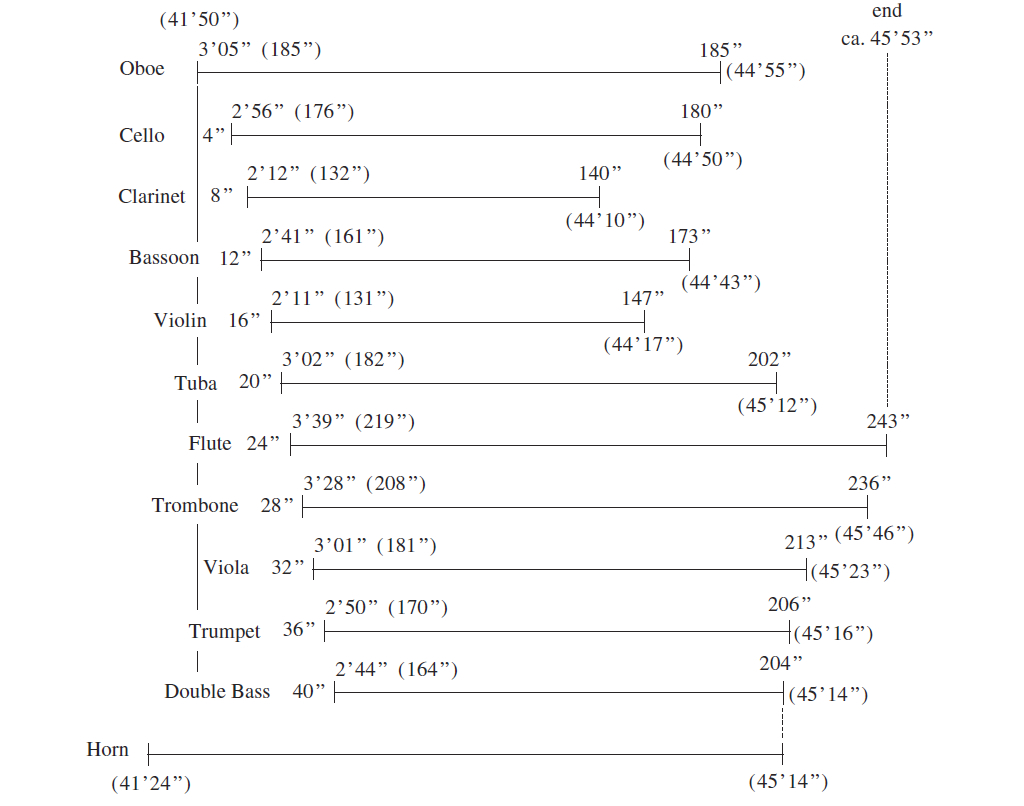
Close transmitters at the end of the soli.
Staging ORCHESTRA FINALISTS
The element of WEDNESDAY from LIGHT – and thus also of the second scene, ORCHESTRA FINALISTS – is air.
In the first scene, the WORLD PARLIAMENT is in session above the clouds on the top floor of a skyscraper or in a floating glass dome, accessible from glass elevators in which the parliamentarians arrive from below. The blue sky surrounds it, and sometimes helicopters and doves fly by.
In ORCHESTRA FINALISTS the orchestra floats high up in the air, far away: the individual soloists fly closer, each of them in and above his (her) own space.
A telescopic observation of the stage reveals, through the telescope and corresponding to the music, the towering roof of a cathedral, aeroplanes flying over the sea, a harbour, etc. The electronic music delineates 11 spaces. They follow each other in succession, are superimposed in three layers for various lengths of time, and are clearly differentiated through octophonic spatial projection:
1 oboe above a cathedral;
2 cello above an airport by the sea;
3 clarinet above a harbour (also with aeroplanes);
4 bassoon above a railway train with steam locomotive;
5 violin above a bird reserve (also individual birds);
6 tuba in flocks of birds and swarms of bees;
7 flute above a kindergarten with little goats;
8 trombone above a swimming pool with elephants;
9 viola with wild geese above a railway train;
10 trumpet above a market-place in Marrakech, zebras, lions, wild geese, horses;
11 double bass above a sailing-ship with tree frogs, rattletrap.
Objects inherent to these spaces protrude out of the floor. Above this, each soloist floats back and forth in a particular way (each also flies at a different altitude). At the end, all fly upwards in different directions, playing.
Sound equipment
5 + 6 cable microphones on the stage (Option A).
4 transmitters (Option A), preferably 10 transmitters, with special microphones (Option B).
l mixing console at the middle of the hall (32 → 8, 4 VCA faders).
l 16-track digital tape recorder (for example two Tascam 8-track tape machines) with time code drive.
8 x 2 loudspeakers in a cube (I to VIII).
The electronic music is projected octophonically.
8 x 2 loudspeakers in a cube:
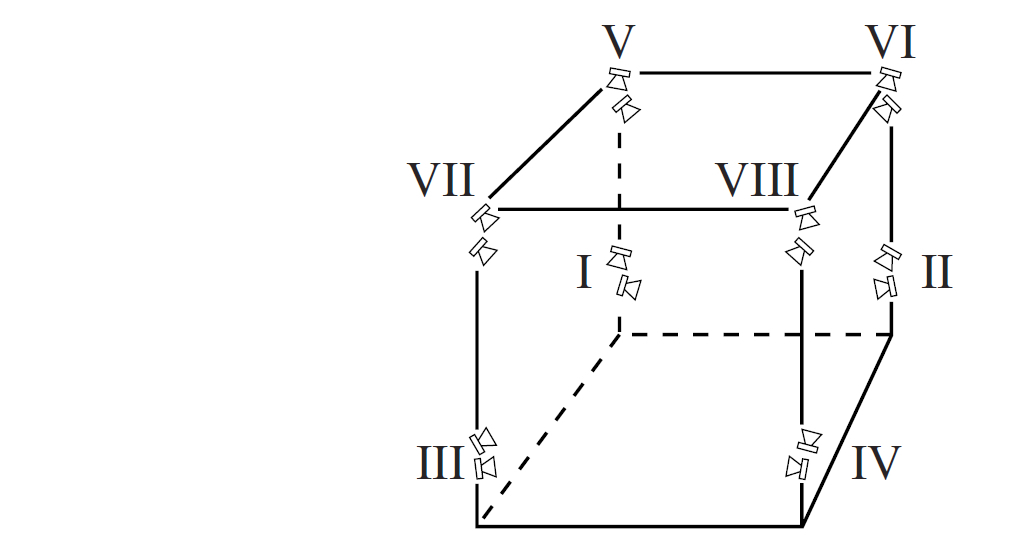
The microphones for the transmitters must be attached to each instrument in
a special way. On the trombone, tuba, and trumpet the microphone is held
next to the opening of the bell by a thick wire attached to the tuning slide
(not to the bell). For the double bass, it is affixed high up on the player 's left
shoulder to amplify the voice and the drumming of the left hand on the body
of the instrument. On the violin and viola it is affixed on the player's chest
or, if a contact microphone, to the bridge. For the flute, oboe and bassoon it
is attached at the upper left on the chest, and for the clarinet it is held above
the keys by a special wire mount on the instrument.
When 10 transmitters are used, one transmitter microphone is not enough to sufficiently amplify the bassoon. To avoid having another microphone on a stand at the middle of the stage, I placed one on a high stand at the far right for the bassoon. Before his solo and also for the final tutti, the bassoonist went and played there.
For the double bass player, in addition to the transmitter microphone,
two additional microphones are necessary: one (microphone 5) in front of
the double bass on a low stand directly below the edge of the bridge, and
one
(microphone 6) on a stand at the left side of the player pointed at the
finger-board in order to ensure sufficient amplification of the scraping noises
at the beginning of each bar of his solo starting at bar 11
At the present time, all mixing consoles allow panorama settings only between odd (left) and even (right) group outputs. Therefore, for this composition the loudspeaker groups are correspondingly numbered: I-II lower front, III—IV lower rear, V—VI upper front, VII—VIII upper rear.
For rehearsals, a 16-track tape is used (or two synchronized 8-track tapes). On
tracks 1- 8 of the first tape are the 8 tracks of the electronic music. Tracks
9-16 are used only for rehearsals. Tracks 9-10: stereo mix of the instrumental soli with chords and final tutti; tracks 11- 12: stereo mix of the electronic music; tracks 13-14: dynamically balanced stereo mix of the
electronic music and instruments including horn; track 15: horn only
dynamically the same as on tracks 13-14); track 16: extra time code (if
necessary).
The stereo pairs may be played back during the rehearsals to help
the soloists' orientation and for comparison. For performances, only one
8-track tape recorder is necessary for playing back the electronic music
on tracks l-8.
The individual musicians may practise using stereo tapes of the electronic music (full level, to be balanced with the instruments), of the instrumental soli, and of the electronic music plus instruments. These tapes may also be ordered from the Stockhausen-Verlag.
Mixing console configuration for 16- (15-) track tape, 11 microphones, 4 transmitters (Option A)
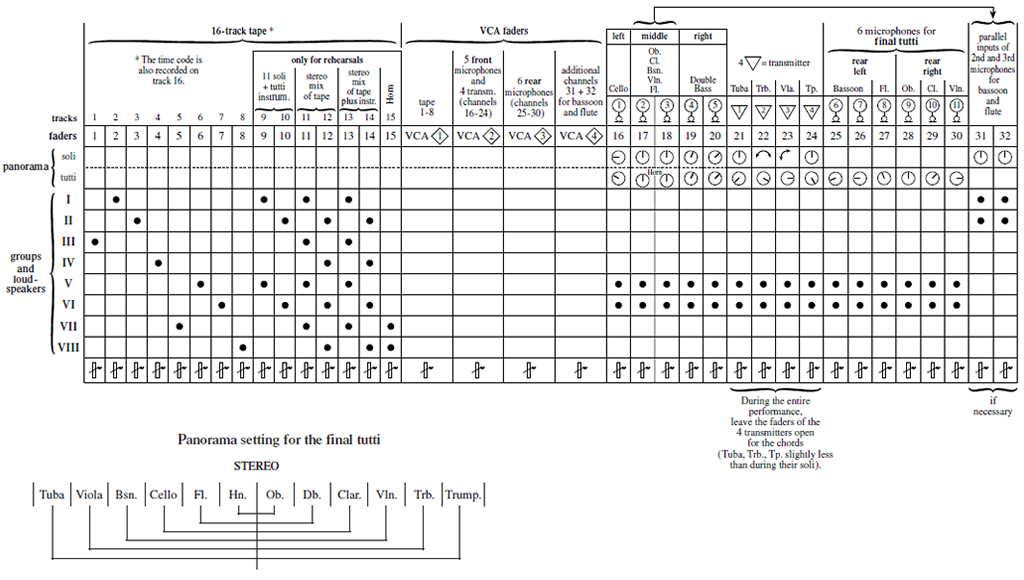
Alternative mixing console configuration for 16- (15-) track tape, 6 microphones, 10 transmitters (Option B)
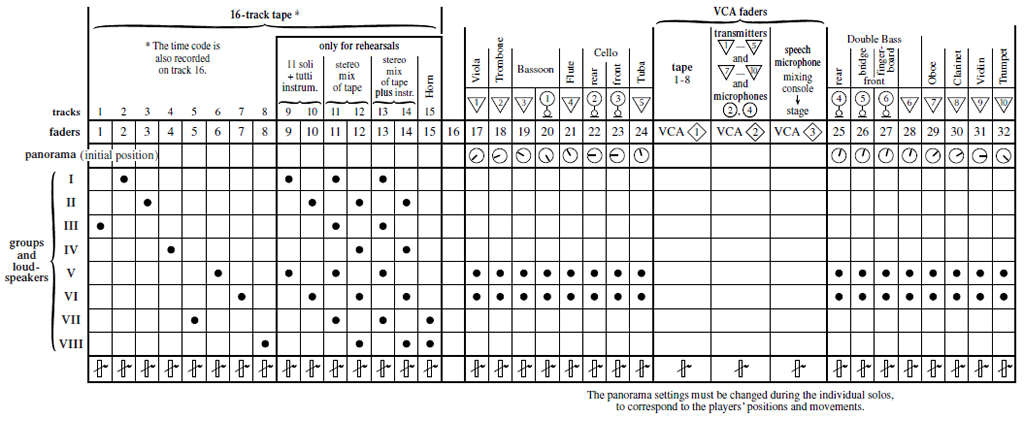
Performance of the individual soli
As mentioned on page VII, in concerts the 11 soli may be performed individually or in groups with tape.
Before a solo, the auditorium lights are slowly faded out and a special lighting for the soloist is slowly faded in. Parallel with the fading in of the lighting, the sound projectionist fades in the tape according to the following list, and during this, the soloist slowly enters and walks to the place where he begins to play his solo.
After the end of a solo, the soloist slowly leaves, and the sound projectionist fades out the tape, during which the light is also faded out slowly.
For the fade-ins and fade-outs the sound projectionist uses the complete
score of ORCHESTRA FINALISTS. In the individual scores for the
soloists, the timings of the complete score are indicated, corresponding to
the time code on the 8-track tape.
For rehearsals and possible stereo performances, a compact disc of the electronic music may be ordered together with the score from the Stockhausen-Verlag. On this CD, the beginning points of the fade-ins for the soli are indicated by track numbers.
If two or three soli are performed in the same concert, and if these soli immediately follow each other in the complete score, the fade-ins and fadeouts between the soli are omitted. In consideration of the concert planning, lengthy periods of only electronic music between the soli should be avoided. Only one solo without instrumentalist may be played with tape alone.
If several soli which are temporally widely separated are performed in a
programme, then the fades of sound and light must be made.
CD tracks
 Oboe from the beginning of the tape to 5' 16" (duration 5'16").
Oboe from the beginning of the tape to 5' 16" (duration 5'16").
Fade-in and fade-out are on the tape.
 Violoncello 5'16" - 8'39" (duration 3'23").
Violoncello 5'16" - 8'39" (duration 3'23").
Fade-in and fade-out are on the tape.
 Clarinet 3'33" - 11'37" (duration 2'59").
Clarinet 3'33" - 11'37" (duration 2'59").
Fade in in 2 seconds, fade out before 11'37" (starting at circa 11'25").
 Bassoon 11'03" - 14'53" (duration 3'50").
Bassoon 11'03" - 14'53" (duration 3'50").
Begin at full level at 11'03 ", slowly fade out starting at 14'36".
 Violin 14'27" - 11'47" (duration 3'20").
Violin 14'27" - 11'47" (duration 3'20").
Fade in from 14'27" to 14'32 slowly fade out from 17'32" to 17'41".
 Tuba 17'09" - 21'30" (duration 4'21").
Tuba 17'09" - 21'30" (duration 4'21").
Begin at 17'09" at full level, fade out from 21'14" to 21'30".
 Flute 20'47" - 26'00" (duration 5'13").
Flute 20'47" - 26'00" (duration 5'13").
Fade in from 20'47" to 20'52", fade out from 25'43" to circa 26'00".
 Trombone 25'31" - 29'43" (duration 4'12").
Trombone 25'31" - 29'43" (duration 4'12").
Fade in from 25'31" to 25'37", fade out just before 29'43".
 Viola 29'00" - 33'33" (duration 4'33").
Viola 29'00" - 33'33" (duration 4'33").
Fade in from 29'00" to 29'10", fade out from 33'20" to 33'33".
 Trumpet 32'30.5" - 36'55" (duration 4'24.5").
Trumpet 32'30.5" - 36'55" (duration 4'24.5").
Begin at 32'3O.5 "at full level, gently fade out at 36'55".
 Double bass 35'57" - circa 44'18" (duration 8'21").
Double bass 35'57" - circa 44'18" (duration 8'21").
Begin at 35'57" at full level, slowly fade out starting at 43'00".
The chords are omitted in the scones of the individual soli.
As in a performance of the entire ORCHESTRA FINALISTS, all soli must always be played from memory with the prescribed movements.
CD 52 of the Stockhausen Complete Edition is recommended for study purposes.
Notation
The score does not include a detailed transcription of the tape.
A form scheme with indications for the three layers E(VE), M(ICHAEL), L(UCIFER) is reproduced following the score.
Timing
Above each solo stands the tape timing of the characteristic event which
serves as orientation for the soloist's entry (for example above the first solo,
oboe: click of ventilator being switched on 1'31", entry 1'44").
The indication elektr. Fagott  above the bassoon solo refers to a sampled bassoon tone on this pitch.
above the bassoon solo refers to a sampled bassoon tone on this pitch.
Each soloist tries out when he should stand up and walk to the front, or to the half-left (cello), right (bassoon), or half-right (double bass).
The tape timings of striking events are in bold print. These include sung or
called syllables and words, as for example the soprano voice in the solo of
the flute:  etc.
etc.
Timings in brackets are the solo timings of the first recording for a compact
disc (Stockhausen-Verlag CD 52). This recording can also be played back
during rehearsals with the 16-track tape ( 2 x 8 tracks of the Tascam DA-88
tapes). The track distribution of this tape is: tracks 1-8 electronic music,
tracks 9-10 instruments only, tracks 11-12 electronic music only, tracks
13-14 instruments plus electronic music (with time code).
At the end of each solo the approximate duration of the solo is indicated
together with a timing indication for a striking tape event, for the soloist's orientation (for example following the oboe solo: "pater noster" - click of switch at 4'47.5" means that a priest sings "pater noster" immediately followed by the click of a ventilator being switched off).
Often, an additional timing indicates the duration until the characteristic event preceding the beginning of the next solo (for example following the
oboe solo: 28.5" until the sea and sea-gulls).
The sketches of ORCHESTRA FINALISTS with all details about the tempo curves of the soli and about the composition of the electronic music have been published by the Stockhausen-Verlag in a booklet entitled Stockhausen Courses Kürten 1998, Composition Course (German and English).
♩ = 53,5 = metronome tempo 53.5. Due to the approximate calibration of most metronomes, it is necessary to choose the nearest tempo (for example 54 instead of 53.5). It is hoped that in the near future, metronomes will be available which have 12 chromatic tempi (numbered 1 to 12) within the temporal octaves 15 - 30 - 60 - 120 - 240.
tempo scale of ORCHESTRA FINALISTS
| 23.75 | 25 | 26.75 | 28.25 | 30 | 31.75 | 33.5 | 35.5 | 37.5 | 40 | 42.5 | 45 | |
| 47.5 | 50 | 53.5 | 56.5 | 60 | 63.5 | 67 | 71 | 75 | 80 | 85 | 90 | |
| 95 | 101 | 107 | 113.5 | 120 | 127 | 134 | 142 | 150 | 160 | 170 | 180 | 208 |
rit. = slow down to half-tempo.
molto rit. = slow down to quarter-tempo.
vibr: = vibrato. Often, the vibrato-tempi are notated; either precisely,
as for example in bar 20 of the oboe solo: vibrato tempo
160 (17 à 160), or approximately, as for example in bar 3
of the clarinet solo: fast - rit. - accel. / slow / fast.
 = breathing pause within the measured duration.
= breathing pause within the measured duration.
 = caesura added to the measured time (often with indication in
= caesura added to the measured time (often with indication in
seconds, otherwise, of various lengths).
 = staccato is always short, regardless of the note value above which it stands.
= staccato is always short, regardless of the note value above which it stands.
 = although all note values without staccato should be held for
= although all note values without staccato should be held for
their full value, a line above a note is a reminder of this.
 = The dynamics for the oboe solo are indicated below the notes
= The dynamics for the oboe solo are indicated below the notes
by a staff with 5 lines. Crescendi and decrescendi within this
staff should be played precisely.
Flzg. = flutter-tongue.
Movements
In each solo there are indications for movements. These are to be performed
by the soloist in a ritualistic way (for example in bar 12 of the oboe solo:
oboe very high | bow | high again | very deep bow | normal position).
Some movements are very unusual (as in the trombone solo). They demand skilled interpreters and special training.
Chords
In a performance of the entire ORCHESTRA FINALISTS, 5 chords are played within each solo. The pitches for these are not assigned to particular instruments, so their instrumentation is free. However, at the end of this score, all these chords 1.1-1.2-1.3-1.4-1.5 to 11.1-11.2-11.3-11.4-11.5 are reproduced in an instrumentation chosen by me, which was used in the first performances (see pages 27–30).
Each soloist synchronises the 5 chords from where he (she) is playing, by
turning to the other players and giving clear upbeats.
As said on the previous page, the chords are omitted in performances of individual solos.
Sound projection
Above the staves are indications in bold type for balancing the tape playback and solo. This is done by the sound projectionist from the middle of the auditorium.
Test material is on the tape at the following absolute timings:
1:50'00" track announcement for tracks 1–12 simultaneously,
at 1:52'00" reference tone -8 dB on all tracks,
at 1:53'30" periodic noise -12 dB,
at 1:56'00" rotating track announcement (1– 12),
at 1:59'30" rotating periodic noise (8-channel),
at 2:03'00" noise 12-channel.
If there is no special reason to check the adaptation of the 16-track playback
and the mixing console, then one starts the tape at 1:56'00" with the
rotating track announcement (tracks 1 to 8 for the electronic music) and
chooses a dynamic level for forte, all channels heard equally loud.
The gain at the input of the mixing console should be set so that the position
of the group fader (VCA) for tracks 1 - 8 is at zero. If this is not possible,
then it is necessary to draw a scale next to the VCA fader.
The fader position for forte of the soli should be set so that when the tape is played back while the instrumentalist is playing, all details of the
solo are clearly intelligible.
Thus, the indications for the tape balancing are as follows:
 -3 = diminuendo to minus 3 decibels,
-3 = diminuendo to minus 3 decibels,
 -5 = diminuendo further to minus 5 dB,
-5 = diminuendo further to minus 5 dB,
 -2 = crescendo to minus 2 dB,
-2 = crescendo to minus 2 dB,
 +2 = crescendo to plus 2 dB (i.e. 2 dB above 0),
+2 = crescendo to plus 2 dB (i.e. 2 dB above 0),
etc.
Depending on the acoustics, and the playing intensity of the soloists, some
of the tape balancing may be slightly different or may even be omitted.
In several soli, not only must the tape be balanced, but also the solo.
This balancing is notated only in some places. In any case, no detail of a
solo should ever be covered.
The indications for balancing a solo are:
 = amplified much more than usual (for example + 12 dB),
= amplified much more than usual (for example + 12 dB),
 = amplified more than usual (for example + 6 dB),
= amplified more than usual (for example + 6 dB),
 = normal amplification again,
= normal amplification again,
 = amplified less than usual
= amplified less than usual